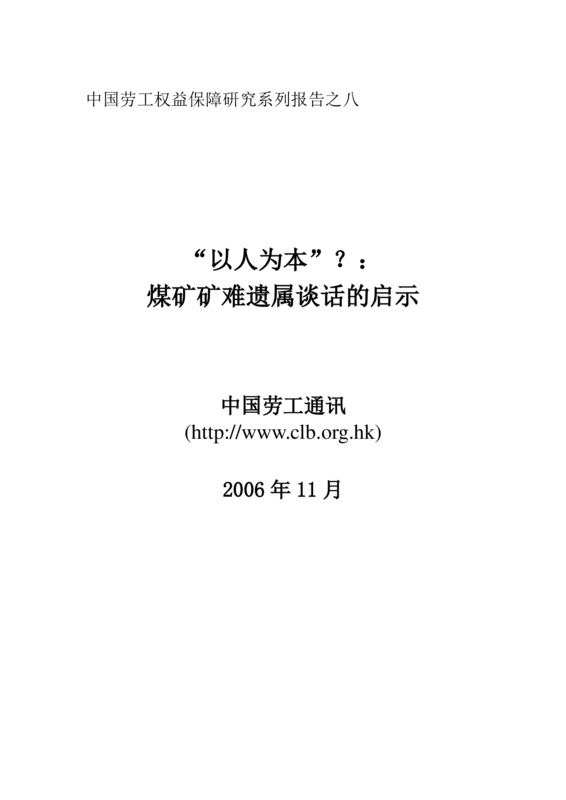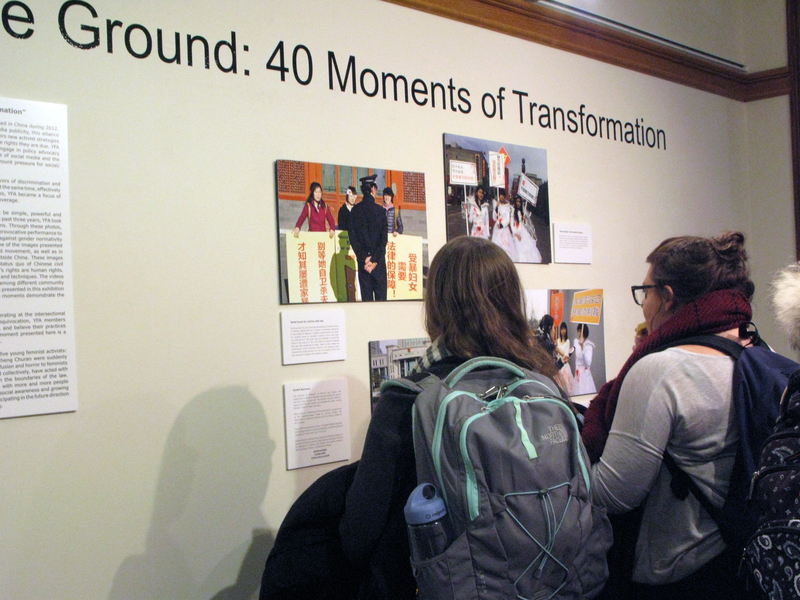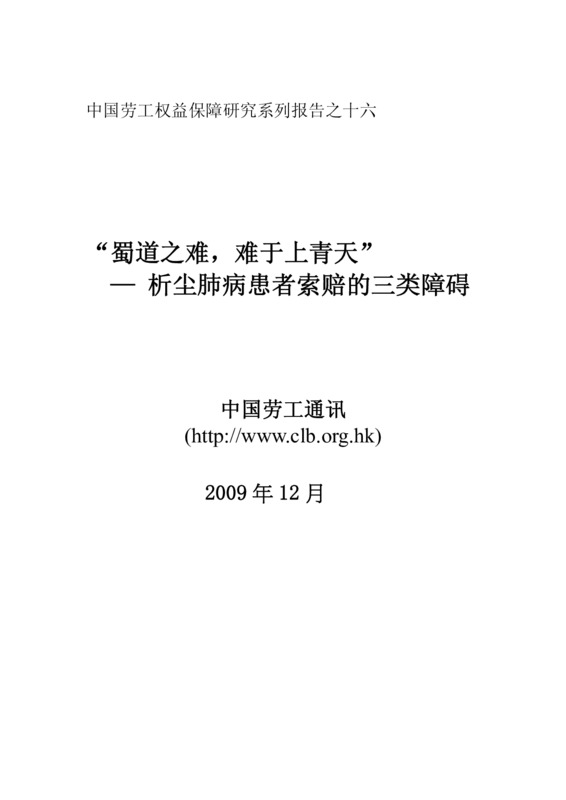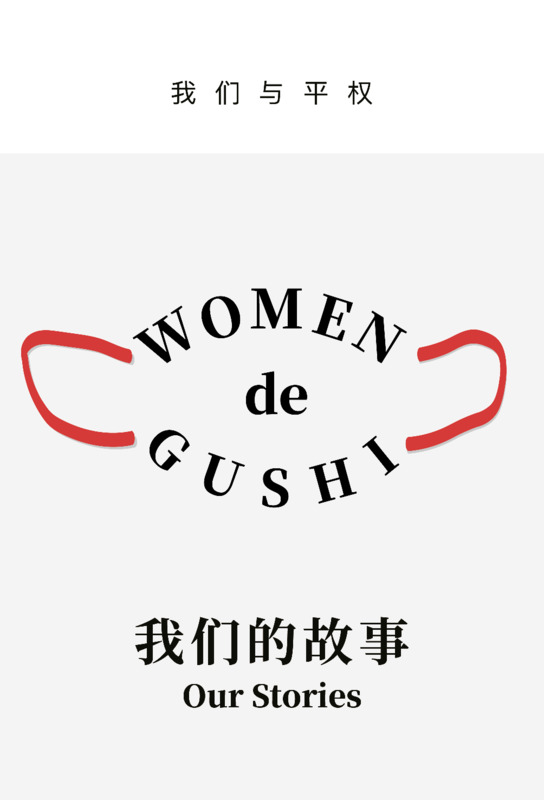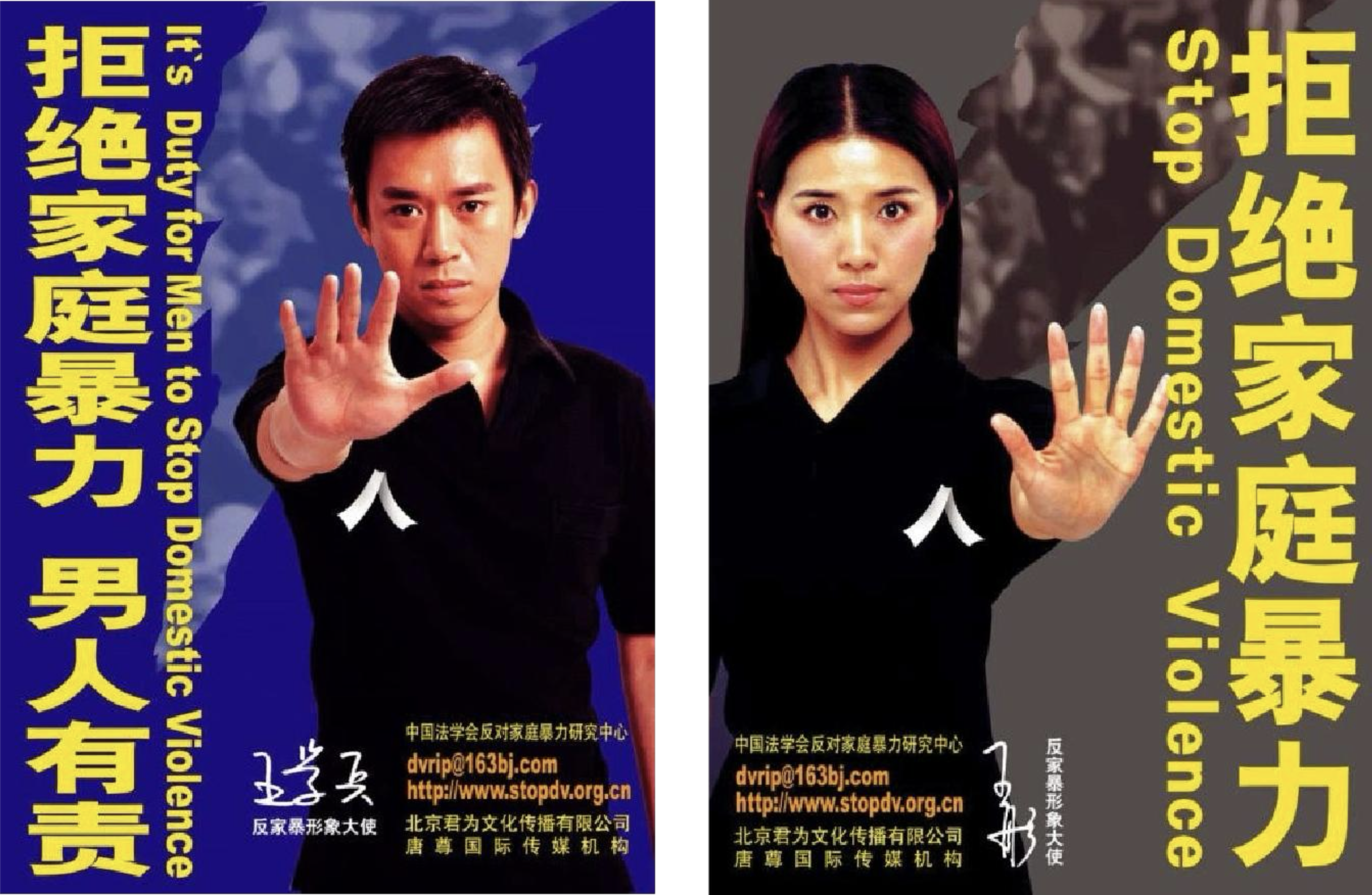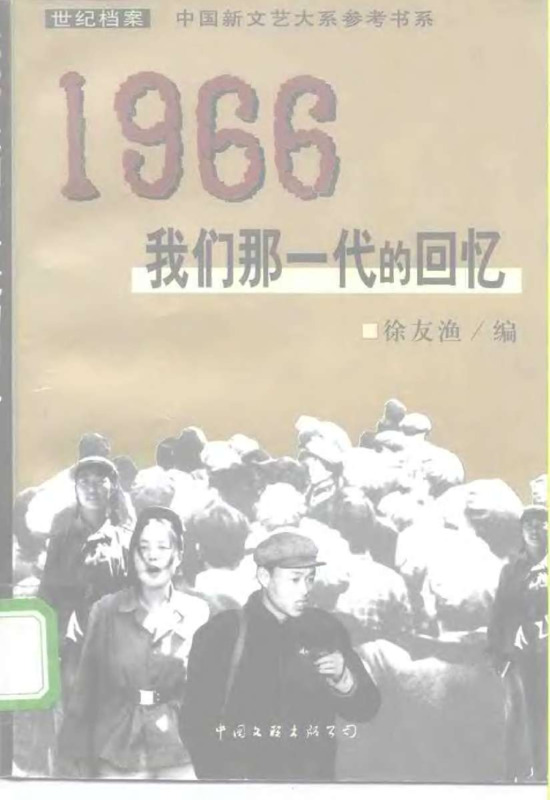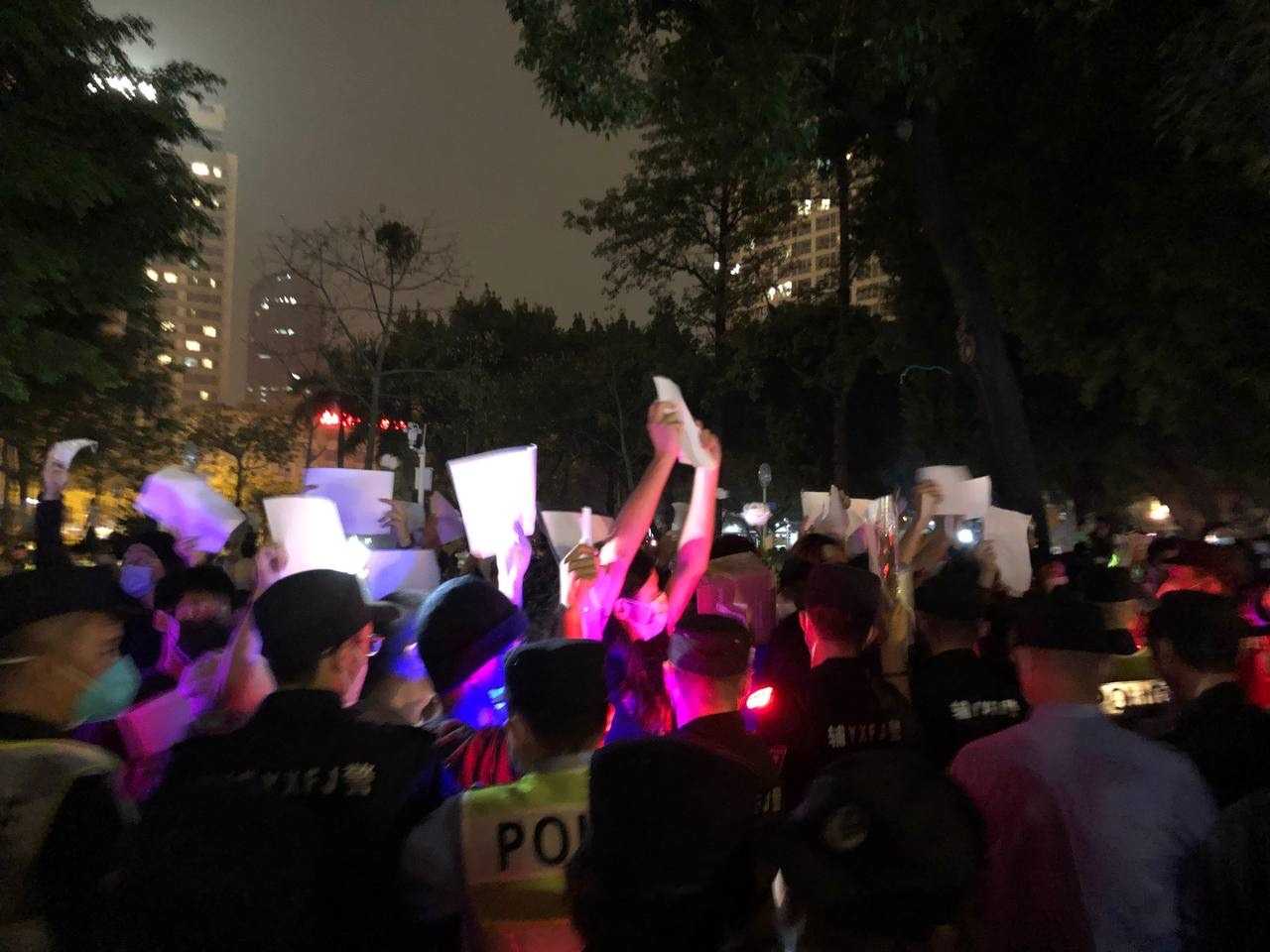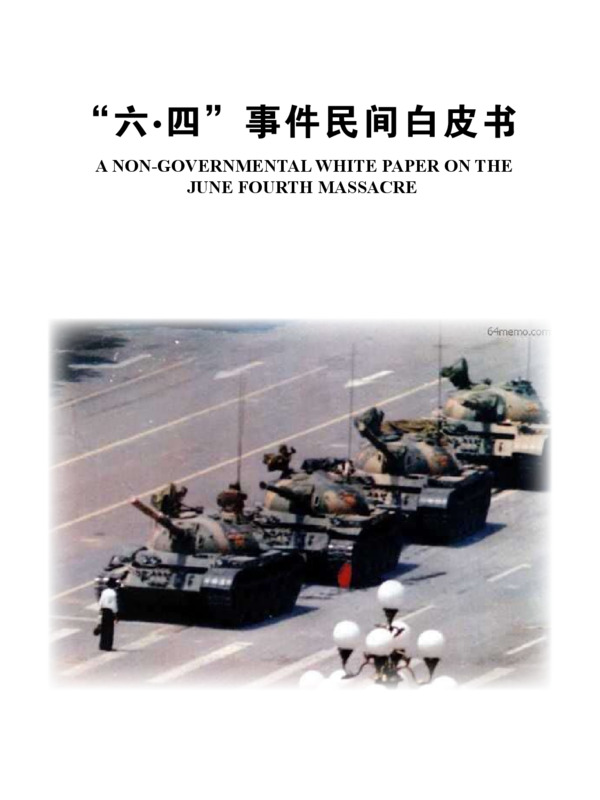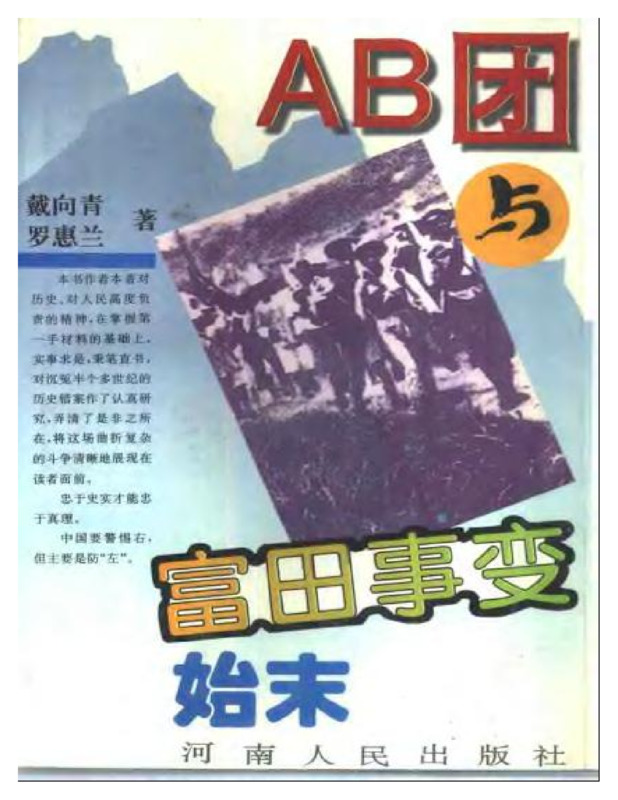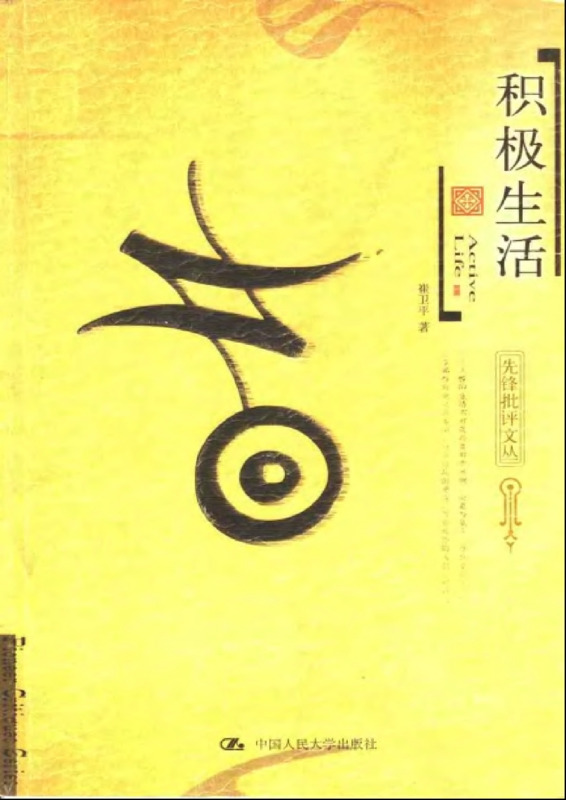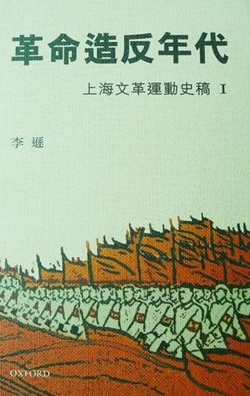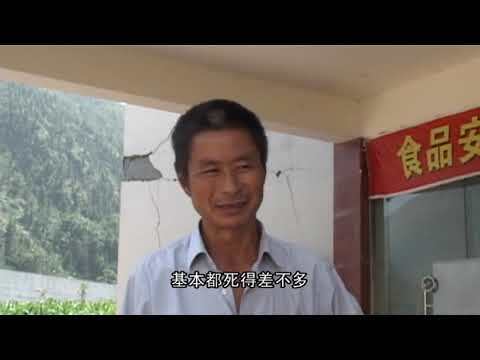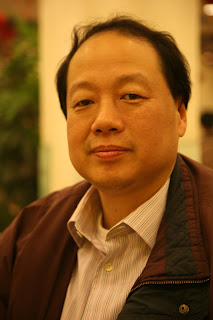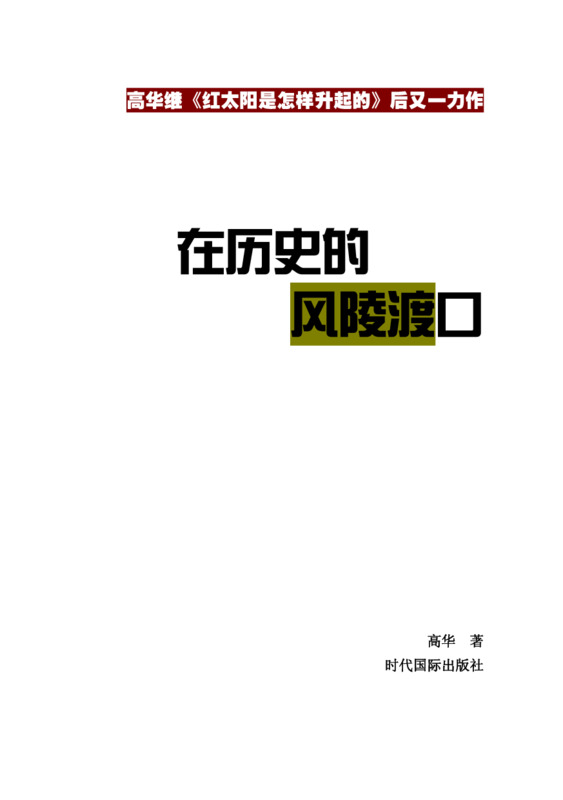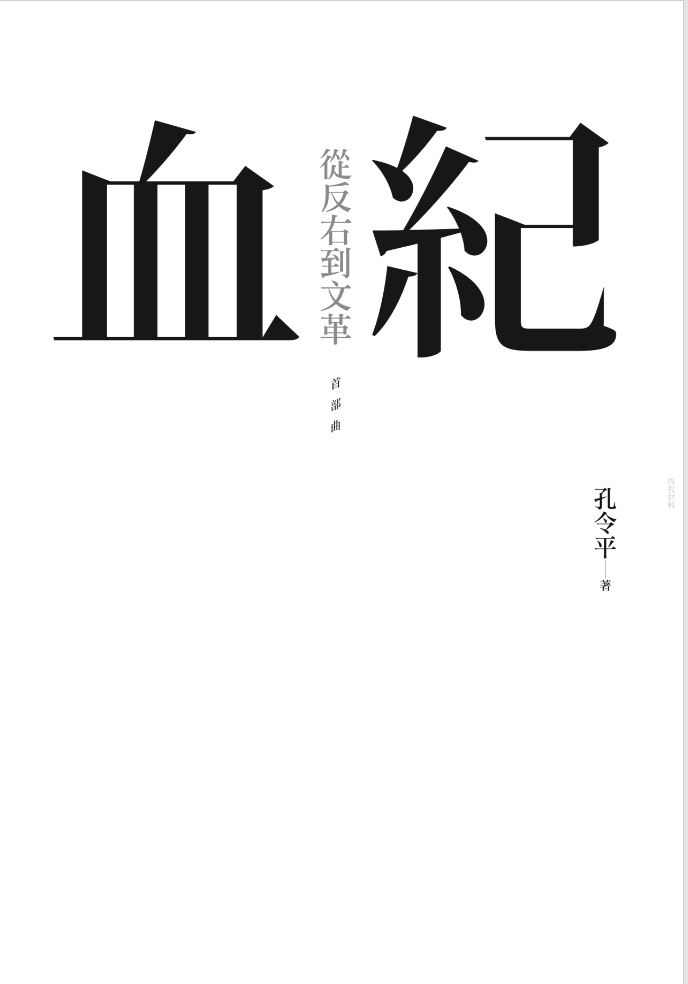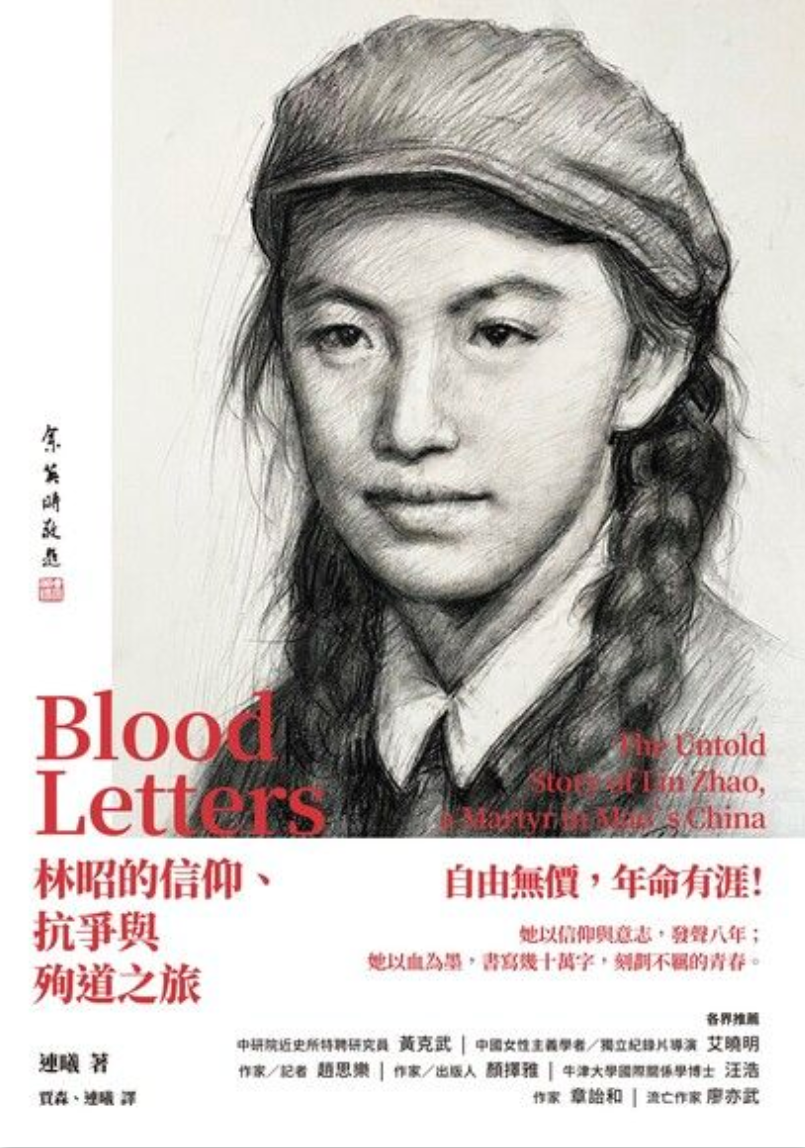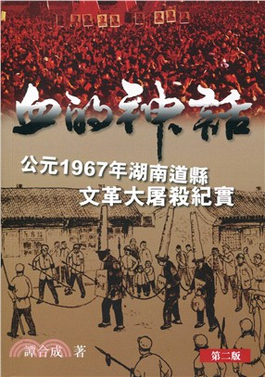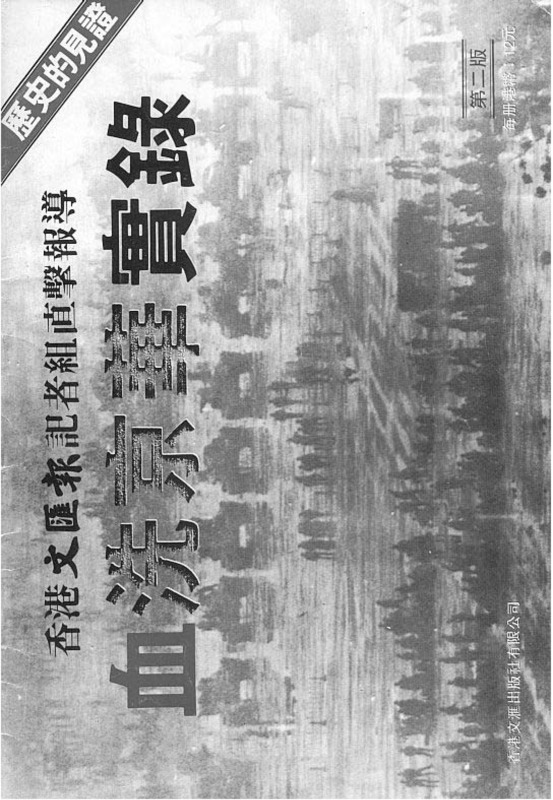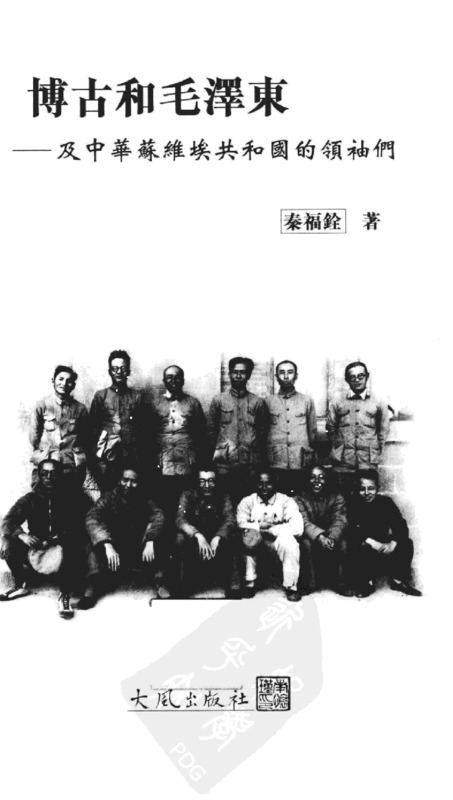Explore the collection
Showing 418 items in the collection
418 items
展览
Above Ground: China's Young Feminist Activists and Forty Moments of Transformation (English)
In March 2015, the arrest and detention of five activists in China brought international attention to the feminist movement in that country, which had already been battling gender discrimination, sexual harassment, violence against women, and homophobia for many years. While the West has only recently turned its attention to the “Feminist Five” and their fellow activists, China has a long and deep history of feminist thought and action. This exhibit seeks to make visible the work of recent feminist activists in China, to share their work with a broader audience, and to spark interest in the history and present of feminist activists, advocates, and scholars in China.
This digital exhibit is a faithful representation of a physical exhibit of the same name, which was hosted by the University of Michigan’s Institute for Research on Women and Gender from January through June 2016.
The exhibit (English) consists of 40 images depicting street actions and online campaigns initiated by young feminist activists, raising awareness and demanding government actions around issues of domestic violence, sexual harassment, education and employment equality, rights of sexual minorities and marginalized groups , and so on.
At the opening of the physical exhibit on January 26, 2016, Lü Pin, the curator of the exhibit and a long time feminist activist and researcher, remarked on the creative and subversive strategies of the young feminist activists:
“That’s why this was a story about visibility from the very beginning. First of all, they wanted people to have to notice this issue. Second, they wanted people to have to notice this group of people. ‘Noticing the issue’ was not just about making the issue of women’s rights become well-known, more importantly, it meant that the issue had to be accepted as a public issue that society would acknowledge as something that was very important. This was not something for women, or something private. Next, as we all considered this to be an important matter, the government had to respond. Thus, in this process, communication or media was very crucial, because it could amplify the power of the unknown.”
Using materials from the physical exhibit, this digital exhibit was created by librarians from University of Michigan Liangyu Fu (Chinese Studies) and Meredith Kahn (Women’s Studies), who created additional descriptive information for the images, as well as a bibliography of relevant sources.
Go to Exhibit: https://apps.lib.umich.edu/online-exhibits/exhibits/show/aboveground.
Book
Our Stories: Women in COVID-19 in China
This is the fourth issue of the “Our Stories” series published by WeChat public account “We and Equality,”, a compilation of 20 oral narratives from Chinese people who lived through the COVID-19 pandemic firsthand, and a personal reflection by the author of this issue, Qiao Yilin. The editors hope to “document the history of ordinary people, to combat the forgetting that should never have happened, and to present the real experiences, feelings, and voices of all of us–to help us remember what has happened to us.”
The interviewees in this volume are diverse, including those of different ages, educational background, ethnicities, physical and mental status, sexual orientations,marital status, and mobility. They shared their own memories of the pandemic, including facing threats to their survival due to food shortage, not being able to take anti-depression medication due to the lockdown, international students having a hard time returning to China, people with hearing impairments facing various inconveniences, and the discrimination faced by those who had recovered from COVID-19Although primarily focusing on experiences and feelings during the pandemic, many interviewees shared additional personal stories that provided useful background information for readers to understand their situation during the pandemic.
In addition to these personal narratives, “We and Equality” also published a 44-question “Women's Mental Health Questionnaire” on WeChat, asking about respondents’ experience during the pandemic, including their sense of belonging, care/housework commitments, sleep quality, emotional and mental status, feeling about quarantine, lockdown, illness or death of loved ones, and attitudes towards the government’s COVID-19 policies. The questionnaire received a total of 453 valid responses. Based on the responses, “We and Equality” has compiled a bilingual data analysis report.
”We and Equality" is a grass root project started in November 2016. Through the WeChat public account, they publish articles weekly to raise awareness and share knowledge on gender-related issues in China. They also organize in-person activities bi-weekly where people gather for in-depth discussion, and foster a community to promote gender equality.
期刊
Istiqlal mejmu’esi/The Independence
“Istiqlal” mejmu’esi 1930-yillarning bashliridiki Sherqiy Türkistan milliy inqilabi we uning netijiside qurulghan Sherqiy Türkistan Islam Jumhuriyiti heqqide birinchi qol tarixiy menbe bergüchi siyasiy, ijtima’iy, iqtisadiy, diniy, edebiy we tenqidiy mejmu’edur.
20-esirning aldinqi yérimidiki Sherqiy Türkistanning siyasiy we ijtima’iy tarixi tetqiqatida Uyghurlarni asas qilghan yerlik xelqlerning aghzaki tarix matériyalliri hemde yazma menbelirige étibar bérilmey keldi. Uyghurlarni asas qilghan yerlik milletler 1930-we1940-yillardiki Sherqiy Türkistanning siyasiy tarixida asasliq rol alghuchi ijtima’iy topluq hésablansimu, emma meyli kommunist Xitay istilasidin kéyinki Xitay hökümet tarixshunasliqida bolsun yaki xelq’aradiki Ottura Asiya tetqiqatida bolsun, ularning öz til-yéziqidiki tarixiy menbeler hemde ularning éytimidiki yerlik tarixchiliq en’enisi izchil halda nezerdin saqit qilinip keldi. Téximu éniqraq qilip éytqanda, Uyghurlarning hazirqi zaman tarixi ularning öz éytimida emes, belki Xitay hökümet tarixshunasliqining ramka ichidiki éytimida yézilip keldi; Ularning öz béshidin ötküzgen tarixiy kechürmishliri ularning öz tili, öz yéziqi we öz hékayiliridiki éytimlarda emes, belki bashqilarning tili, yéziqi we hékayiliridiki wastiliq bayanlarda éytilip keldi. Shundaq, ularning özlirini ipade qilishigha imkaniyet bérilmidi, ular peqet bashqilar teripidin ipade qilinishqa mejbur boldi.
“Istiqlal” mejmu’esi 1930-yillardiki Sherqiy Türkistan milliy inqilabi tarixidiki del mushu boshluqni toldurghuchi Uyghur til-yéziqidiki yigane menbelerning biridur. Eslide mezkur mejmu’eni her ikki heptide bir qétim neshir qilip tarqitish pilanlan’ghan bolsimu, emma 1933-1934-yillardiki Rayonning murekkep we turaqsiz siyasiy weziyiti seweblik, peqetla 1-2 qoshma sani neshir qilinipla toxtap qalghan. Bügünki künde mezkur mejmu’ening esli nusxasini Xitaydiki, jümlidin Shinjang Uyghur Aptonom Rayonidiki herqandaq bir arxip yaki kutupxanidin tapqili hem körgili bolmaydu. “Istiqlal” mejmu’esining birqanche dane esli nusxasi nöwette Seudi Erebistanidiki Türkistan Kutupxanisida, Shiwétsiyediki Lund Uniwérsiteti Kutupxanisi Yarring Yighmisi (Gunnar Jarring Collection)da, Shiwétsiye dölet arxipi (Riksarkivet) da we Istanbuldiki Shiwétsiye Tetqiqat Inistituti (Swedish Research Inistitute) ning kutupxanisida saqlanmaqta.
“Istiqlal” mejmue’si 1933-yilining ikkinchi yérimida Qeshqerde qurulghan Sherqiy Türkistan Istiqlal Jem’iyitining neshir epkari süpitide neshir qilin’ghan. 1931-yili Qomuldin bashlan’ghan Sherqiy Türkistan milliy inqilabi 1933-yilining bashlirigha kelgende jenubqa kéngiyip, aldi bilen Xoten wilayiti yerlik qozghilangchilarning qoligha ötken we Xoten Islam Hökümiti jakarlan’ghan. Shu yili 5-aylarda Qeshqer wilayitimu yerlik qozghilangchilarning qoligha ötüp, Qeshqerde birlikke kelgen musteqil Sherqiy Türkistan Jumhuriyiti qurushning jiddiy teyyarliqi élip bérilghan. 1933-yili 8-ayda Qeshqerde bir qisim yerlik inqilabchi serxillar bash qoshup, aldi bilen Sherqiy Türkistan Istiqlal Jem’iyiti qurghan we musteqil Sherqiy Türkistan Jumhuriyiti qurushning teyyarliqigha jiddiy kirishken. “Istqiqlal” mejmu’esi mezkur jem’iyetning neshir-epkari süpitide qurulghusi Sherqiy Türkistan Islam Jumhuriyiti üchün siyasiy we nezeriyiwiy asas tiklesh meqsitide neshir qilin’ghan.
“Istiqlal” mejmu’esining 1933-yilliq tunji sani (1-2-qoshma sani)da mezkur mejmu’ening meqset-nishani, Sherqiy Türkistan Istiqlal Jem’iyitining nizamnamisi, Qeshqerde Sherqiy Türkistan Islam Jumhuriyitining qurulushi we hökümet bayannamisi, hökümet teshkili we kabént ezaliri, Sherqiy Türkistan Islam Jumhuriyitining asasiy qanuni, Sherqiy Türkistan milliy inqilabining qisqiche tarixi, Sherqiy Türkistan xelqige qilinghan chaqiriq, Chet’ellerdiki Türk-musulman qérindashlargha muraji’et, Sherqiy Türkistan dölitining yéngi pul-mu’amilisi qatarliq höjjet xaraktérliq muhim matériyallar bérilgen. Mejmu’ening kéyinki bölikide Sherqiy Türkistandiki eng yéngi weziyet we milliy inqilab xewerliri hemde Qeshqer ehwali tonushturulghan. Alahide tekitleshke tégishlik yéri shuki, mejmu’ening axiriqi sehipiliride Sherqiy Türkistan Edebiyatigha béghishlan’ghan mexsus maqalilar, she’irlar, chaqiriqlar, mektep balilirining naxsha tékistliri we Sherqiy Türkistan marshi bérilgen.
Mezkur mejmu’ediki höjjet xaraktérliq matériyallar 1933-yilidiki Sherqiy Türkistan Islam Jumhuriyiti tarixini tetqiq qilishta birinchi qol muhim menbe hésablinidu. Bu mejmu’ege bésilghan Sherqiy Türkistan Islam Jumhuriyitining Asasi Qanuni shu mezgildiki musulmanlar dunyasida küchlük tesir peyda qilghan. Eyni waqitta Yawropada siyasiy pa’aliyet élip bériwatqan Türkistan muhajirliri Qeshqerde neshir qilin’ghan “Istiqlal” mejmu’esidiki bir qisim maqale we höjjetlerni tashqiy dunyagha tonushturghan. “Istiqlal” mejmu’esining tunji sanigha bésilghan Sherqiy Türkistan Islam Jumhuriyitining Asasiy Qanunining toluq tékisti Fransiye paytexti Parizhda neshir qiliniwatqan “Yash Türkistan” mejmu’esining 1934-yilliq 3 sanigha uda ulap bésilghan.
“Istiqlal” mejmu’esining ich muqawisigha “bu mejmu’ening shu’ari dinda, tilda, dilda, pikirde we ishta birlik” dep yézilghan. Bu shu’ar 19-esirning axiriqi charikide Rusiye musulmanliri arisida bashlan’ghan jeditizm herikitining bayraqdari Ismail Gaspirinski (1851-1914) teripidin otturigha qoyulghan “tilda, pikirde we ishta birlik” dégen meshhur chaqiriqtin élin’ghan.
“Istiqlal” mejmu’esi Hijriye 1352-yilining Ramizan éyida, Miladiye 1933-yilining 11-12-ay mezgilide Qeshqerde neshir qilinip tarqitilghan. Mezkur mejmu’ening bash muherriri Muhemmed Emin Sufizade bolup, u 20-esirning bashlirida Tashkent, Buxara, Istanbul we Misirda oqughan. 1920-yillarda Rusiye Türkistanida Bolshéwiklar hakimiyitige qarshi qurbashilar (basmichilar) herikitige qatnashqan. 1930-yillarning bashliridiki Sherqiy Türkistan milliy inqilabi mezgilide neshriyatchiliq we teshwiqat ishlirida aktip rol oynighan. Qeshqer we Aqsu qatarliq jaylarda oqutquchi bolup, zamaniwiy milliy mekteplerni rawajlandurushta hesse qoshqan. 1937-yili Sherqiy Türkistan milliy inqilabi meghlub bolghandin kéyin qolgha élinip, Ürümchide militarist Shéng Shisey türmiside öltürülgen.
“Istiqlal” mejmu’esining tili klassik Türki-Uyghur (Chaghatay) tilidin hazirqi zaman Uyghur tiligha ötüsh mezgilidiki ötkünchi dewrge mensup bolup, uningdiki maqale-eserler til, yéziq, imla we ipadilesh jehettin pütkül Türki tilliq xelqler chüshineyleydighan ortaq edebiy tilda yézilghan. Bu mejmu’ediki maqale-eserler hazirgha qeder Xitay, In’giliz yaki bashqa tillargha terjime qilinmighan.
The irregular periodical <i>Istiqlal (The Independence)</i> is a firsthand historical source concerning the national independence movement that erupted in East Turkestan in the early 1930s and its direct outcome — the establishment of the East Turkestan Islamic Republic (ETIR) on November 12, 1933. It is a valuable collection of documents that provides critical, self-reflective content about the political, social, economic, religious, and cultural environment of East Turkestan during that era.
In the study of China's frontier history during the first half of the 20th century, particularly in the field of modern political and social history of Xinjiang, oral histories and written records of local people, primarily the Uyghurs, have long been overlooked. Despite the fact that Uyghurs and other indigenous people played a central role as the main social actors in Xinjiang's political history during the 1930s and 1940s, both official Chinese historiography after the rule of the Chinese Communist Party and international scholarship on Xinjiang have consistently ignored historical documents in the languages of Xinjiang's indigenous peoples and their native historiographical traditions. To be precise, modern Uyghur history is not narrated by the Uyghurs themselves but is framed within China's official historical narrative. Their historical experiences are not expressed through their own language, script, and stories but are instead conveyed through the language, script, and narratives of others.
<i>The Independence</i> anthology is a rare historical document in the Uyghur language that fills this gap. According to the original plan of its publishers, Independence was intended to be issued biweekly. However, due to the complex and turbulent political situation in southern Xinjiang during 1933-1934, only the combined first and second issues were published before its discontinuation. Today, the original copies cannot be found in any archives or libraries within China, including the Xinjiang Uyghur Autonomous Region. A small number of surviving original copies are held in the private library of Rahmetulla Turkistani, a Saudi Arabian scholar of Uyghur descent, the Gunnar Jarring Collection at Lund University Library in Sweden, the National Archives of Sweden (Riksarkivet), and the library of the Swedish Research Institute in Istanbul, Turkey.
The PDF version offered here came from the website of <a href="https://www.uyghurkitap.com/">"UyghurKitap" (UyghurBook)</a>. The founders of UyghurKitab website scanned the book and converted it into PDF with the permission of the Library of Rahmetulla Turkistani. CUA got permission from the UyghurKitab to publish it on our website.
Published in Kashgar in the second half of 1933 as the official publication of the East Turkestan Independence Association, the anthology emerged during a pivotal time. The East Turkestan national independence movement, which began in Qomul (Hami in Chinese) in 1931, had spread to various oases around the Tarim Basin by early 1933. The main southern East Turkestan oasis cities such as Hotan, Kashgar, and Aksu were successively brought under the control of local insurgent populations. Various rebel forces began preparations to establish a unified East Turkestan Republic. In August of that year, local rebel elites formed the East Turkestan Independence Association to actively prepare for the founding of the Islamic Republic. The Independence anthology served as the theoretical mouthpiece of this association, aiming to awaken the populace and lay the political and ideological foundation for the forthcoming Islamic Republic of East Turkestan.
The first combined issue of <i>The Independence</i> anthology (Issues 1-2, 1933) includes the following core content:
- The editorial mission and the charter of the East Turkestan Independence Association (ETIA)
- The declaration of the East Turkestan Islamic Republic (ETIR) established in Kashgar
- The composition of the government of the East Turkestan Islamic Republic and the list of cabinet members
- The full text of the Constitution of the East Turkestan Islamic Republic
- A brief history of the East Turkestan national independence movement
- A Letter to the People of East Turkistan and A Letter to Overseas Turkic Muslim Brothers
- An announcement regarding the issuance of new currency by the East Turkestan Islamic Republic
In the later sections, updates on the latest developments in East Turkistan, trends in the independence movement, and reports from the Kashgar region were published. Notably, the final section of the publication featured a dedicated East Turkestan literature column, including essays, poetry, manifestos, ethnic folk songs, and the lyrics to the East Turkestan March.
The documents published in the inaugural issue are indispensable historical materials for a comprehensive study of the East Turkestan Islamic Republic (1933-1934), which holds special significance in 20th-century Uyghur political history. The Constitution of the East Turkestan Islamic Republic, published in the anthology, had a profound impact on the Islamic world at the time. Political activists from Russian Turkestan (or Soviet Central Asia), who were in exile in Europe, introduced parts of the publication and its documents to the international community, including the full text of the Constitution of the East Turkestan Islamic Republic. This was subsequently reprinted over three consecutive issues in 1934 in the Paris-based magazine <i>Yash Türkistan (Young Turkistan)</i>.
The cover of the anthology bears the motto: "Unity in Religion, Language, Heart, Thought, and Action." This slogan is derived from the famous 19th-century initiative "Unity in Language, Thought, and Action," proposed and widely disseminated by Ismail Gasprinsky (1851-1914), a leader of the Russian Tatar Jaditism Movement (Muslim reform movement), in his periodical <i>Terjuman</i>.
<i>The Independence</i> anthology was published in Kashgar during the month of Ramadan in the Islamic year 1352 (November-December 1933 AD). Its editor-in-chief, Muhammed Emin Sufizade, had studied in Tashkent and Bukhara (present-day Uzbekistan), Istanbul (Turkey), and Cairo (Egypt) in the early 20th century. In the 1920s, he participated in the Basmachi movement against Bolshevik rule in Western Turkestan (Russian Central Asia). In the early 1930s, he dedicated himself to propaganda and publishing efforts for the East Turkestan independence movement, founding modern national education schools in Kashgar and Aksu. Following the failure of the East Turkestan independence movement in 1937, he was arrested by the warlord Sheng Shicai and executed in a prison in Urumqi.
The language of the publication largely reflects the transitional form of classical Turkic Chagatay literature into modern Uyghur, using a common written language comprehensible to readers across the Turkic language world. More specifically, the vocabulary, orthography, grammatical structure, and style of expression in the anthology embody the characteristics of early 20th-century Uyghur written language. It should be noted that the content of this anthology has not yet been translated into Chinese, English, or other languages.
Article
The Vagina Monologues' Journey in Mainland China
This article comprehensively documents the journey of the play <i>The Vagina Monologues</i> in Mainland China, including its many performances nationwide, as well as screenings of the play and events based on the play.
The author, Rong Weiyi, is an associate professor at the People’s Public Security University of China and an expert in gender studies, serving as a member of the China Women’s Studies Association, a member of the China Marriage and Family Studies Association, and a special researcher for the China Police Association.
Book
1966: Memories of Our Generation
This book is a collection of nineteen feature articles by well-known contemporary scholars, researchers, and writers. They recapitulate their own experiences during the Cultural Revolution in a literary style.
When the Cultural Revolution broke out, they were all young people in their twenties. These reminiscence articles are the result of a rare collective reflection after the end of the Cultural Revolution. The authors described their own experiences during the Cultural Revolution in the articles, providing a personal perspective on history.
The chief editor of this book is the philosopher and activist Xu Youyu, a former researcher at the Institute of Philosophy, Chinese Academy of Social Sciences. Xu signed and made suggestions on Charter 08, and also is a co-founder of the New Citizens Movement. Since 2015 he has resided in New York City, where he has been a visiting scholar at the New School for Social Research.
This book was published by China Federation of Literary and Art Circles Publishing Corporation in 1998.
Book
A Non-governmental White Paper on the June Fourth Massacre
At the turn of the spring and summer of 1989, democratic protests broke out in Beijing and other cities in China. In the early hours of June 4, the Chinese government dispatched troops to suppress the movement. In 2009, on the occasion of the 20th anniversary of the June 4th Incident in 2009, some participants in the movement jointly released the "Unofficial White Paper on the June 4th Incident". The book has 48 pages and a large number of illustrations.
This white paper attempts to provide a complete political background and legal analysis of the events based on reports from Chinese newspapers, radio and television stations at the time, as well as memoirs and interviews that have been published over the past 20 years. Participants in this book believe that the Chinese government has not conducted a comprehensive investigation and objective evaluation of the June 4th Incident, and has long blocked relevant information and prohibited private investigation and discussion of the matter. The report is called a "white paper" to emphasize its rigor and normative nature.
Participants in this book include Hu Ping, Yan Jiaqi, Wang Juntao, Wang Dan, Yang Jianli and others. The book was written by Li Jinjin, a doctor of law.
Book
AB Corps and the Futian Incident
In 1930, a mutiny erupted in the Red Army in the town of Futian. In the ensuring purge, more than 700 officers were executed. After this, the campaign to root out Anti-Bolshevik (AB) groups spread to various parts of China, with 70,000 executed. Occurring just nine years after the founding of the CCP, it is one of the earliest and most significant purges in the party's early history.
The first person to pay attention to the Futian Incident was Professor Dai Xiangqing of the Jiangxi Provincial Party School. Starting in late 1979, he and other colleagues went to southern Jiangxi to collect materials, conduct interviews and investigate, and found that this was an unjust and wrong case, and began to publish articles on the matter.
In the early 1980s, Dai Xiangqing sent his article to a senior general in the PLA, Xiao Ke. After that, the research on the Futian Incident attracted the attention of senior central officials. The CCP's party history research agency sent people to Hunan and Jiangxi to investigate and collect materials. The Organization Department of the Central Committee of the Communist Party of China sent a review team for the Futian Incident and reported the vindication documents to the central government, but even today there is currently no official conclusion on the matter.
This book is an important study of the early history of the Communist Party of China, often mentioned by prominent independent historians, such as Yang Kuisong. As an officially recognized research project, this book does not make ideological breakthroughs, but its detailed historical materials, and its data index make it particularly valuable for understanding this historical event.
This book was published by Henan People's Publishing House in 1994.
Book
Active Life
This is a collection of essays by Cui Weiping, a professor at the Beijing Film Academy. The title, inspired by Hannah Arendt, covers a wide range of fields from poetry and movies to politics and ethics, and tells the stories of fascinating people, the construction of their inner world and external lives. These people include Hai Zi, Wang Xiaobo, Arendt, Woolf, Beauvoir, Tarkovsky, Kremer, Herbert, Havel, and many others. Behind these seemingly unrelated names, there are hints of these two interdependent spiritual dimensions: on the one hand, the construction of the external world in which we live; on the other hand, the construction of our own inner world, which cannot be neglected. This book, published by Renmin University of China Press in 2003, has had a significant impact on the development of civil society in China.
Book
Age of Revolutionary Revolt: Historical Manuscripts of the Cultural Revolution Movement in Shanghai, The
Shanghai is where the Cultural Revolution was launched, and the Shanghai Cultural Revolution is an important part of China's decade-long Cultural Revolution. This book is an important work about the decade-long Cultural Revolution in Shanghai. It has been commented that "Li Xun's book is the most detailed account of the Shanghai Cultural Revolution to date. Although other perspectives are possible, as far as political history is concerned, the basic framework is complete; and as far as the study and evaluation of the Cultural Revolution is concerned, the core of understanding the movement is almost lost without the Shanghai Cultural Revolution." This book was published by Oxford Press in 2015.
Here is a link to purchase the book from the publisher:
https://www.oupchina.com.hk/zh/general-interest/humanities/archives/2014/24_shanghai-cult-revolution
Film and Video
An Investigation by Citizens
Following the release of the documentary Our Children, this film shifts focus to ’s post-earthquake efforts to investigate and defend the rights of families who lost children in the disaster, as well as the immense obstacles and pressure he encountered in the process.
In late August 2008, after the 100-day mourning period for the May 12 Sichuan earthquake, rescue forces began to withdraw and media coverage of the school collapse deaths ceased, even though many families still had not received a satisfactory explanation as to why so many schools had collapsed while other buildings remained intact. Due to contradictory official statements, selective disclosure of information, and deliberate concealment from the public, environmental activist Tan Zuoren, along with Xie Yihui and local volunteers in Chengdu, launched an independent citizens’ investigation into the victims of the 5.12 earthquake during the winter of 2008. They believed that only those directly affected—namely, the parents—could provide truthful and reliable accounts.
They traveled across residential districts, searching for the causes of the school building collapses, recording the experiences of local residents, and tallying the number of victims. Through autumn and winter, Tan and Xie journeyed across 80 townships in 10 of the worst-hit counties, covering over 3,000 kilometers. Just before the one-year anniversary of the earthquake, they published their findings online, marking the first independently conducted citizen investigation into the school tragedies of the Sichuan quake.
During the investigation, Tan Zuoren stated, “There’s a high chance I’ll be arrested and sentenced to three or five years. I’ve already mentally prepared myself for that. But in the face of such a massive disaster, if no one stands up to speak, if we all shrink back like turtles hiding in their shells—then I’d rather spend those three or five years not seeing anyone.” As Tan anticipated, he eventually lost his freedom. His wife and daughter waited for the results of his trial.
Meanwhile, in Beijing, artist Ai Weiwei initiated a broader citizen movement. New volunteers arrived in Sichuan to compile the names of the children who had died. This film follows their footsteps, documenting their motivations, determination, and the many forms of obstruction they encountered. As Ai Weiwei wrote in a blog post before starting, there were only two scenarios in which he would stop the investigation: either he was no longer alive, or the list was complete. This film is an incomplete record of the citizen investigation. It also served as one of the pieces of testimony submitted to the court during Tan Zuoren’s trial for “inciting subversion of state power.”
Book
Anthology of Essays by Zhang Zuhua, An
Zhang Zuhua is an independent scholar in China. In his early years, he served as a member of the Standing Committee of the Central Committee of the Communist Youth League, Secretary of the Youth League Committee of the Central State Organs. Later, he worked at a private research institute, mainly engaged in political modernization, the theory and practice of constitutional democracy, and China's political reform. He was a key participant in China's Charter 08 in 2008. This book is a collection of his political essays.
Book
At the Crossroads of History
This book is Gao Hua's next masterpiece after *How the Red Sun Rose*. It entails a selection of papers published by the author between 1988 and 2004, covering the fields of Republican history, Communist Party history, and contemporary Chinese history. It captures the historical interaction between the present and the past. Gao reflects deeply on the far-reaching Chinese Communist Revolution. With a rigorous and empirical research methodology, he sketches a complex and colorful picture of history, presenting the multiple facets of twentieth-century China's history.
Book
Blood Chronicle: From the Anti-Rightist Movement to the Cultural Revolution
The author of this book, Kong Lingping, who lives in Chongqing, was labeled as a rightist in his youth. He has lived through all the political movements of the Chinese Communist Party (CCP). This book is based on the author's own experience, from birth to 2009.
Book
Blood Letters: The Untold Story of Lin Zhao, A Martyr in Mao's China
This book is the brainchild of Prof. Lian Xi of Duke University, U.S.A. In March 2018, it was published in English by Basic Books in the U.S.A. In 2021, it was published in Chinese by Taiwan Business Press. Based on a large amount of historical materials as well as first-hand interviews, this book reconstructs Lin Zhao's life. It depicts the political development before and after the birth of New China, and presents the resilient will and beliefs of intellectuals in this era.
To purchase this book, please visit [the publisher](https://www.hachettebookgroup.com/titles/lian-xi/blood-letters/9781541644229/?lens=basic-books), or a bookseller.
Book
Blood Myths
In 1984, CCP’s reformist leader Hu Yaobang sent more than 1,300 officials to Dao County in Hunan Province to investigate mass killings that occurred in 1967 during the Cultural Revolution. Tan joined the team for part of its stay in Dao County. As a writer for a state publication, Tan gained a number of documents unearthed during the investigation and conducted interviews, based on which he wrote an article of 100,000 characters. His editors, however, said it could not be published because the political climate was changing with the start of the "bourgeois liberalization" campaign, which eventually led to Hu's fall. Tan decided to continue his investigation and traveled to Dao County many times to do follow-up interviews. Tan collected millions of words of information, including nearly 400 case studies, and interviewed almost all the key figures who agreed to be interviewed.
In 2010, Tan published Blood Myths: the 1967 Mass Killings in Dao County, Hunan Province during the Cultural Revolution through Hong Kong-based Tianxingjian Publishing House. This nine-volume work consists of 83 chapters and more than 500,000 characters. According to Tan's investigation, in the 66 days from August 13 to October 17, 1967, more than 9,000 villagers, including women and children, were killed or forced to commit suicide because they were wrongly accused of engaging in counter-revolutionary activities. More than 14,000 people were directly implicated in the killings, including 426 state cadres, 2,767 village officials, and 3,880 Communist Party members. Unlike works on the history of the Cultural Revolution previously published in China that focused on the persecution of intellectuals, this book presents the systematic violence suffered by villagers. The book contains not only the words and stories of a large number of those killed, but also those of the killers and others involved, enabling readers to develop an all-encompassing, multi-faceted understanding of this tragic event. According to Yang Jisheng (see separate entry), most of the information about the mass killings currently circulating at home and abroad originated from Tan's investigations and interviews.
The book was reprinted in 2011 and a revised edition was published in 2016, expanding the book to 700,000 words. In 2017, Oxford University Press published <i><a href="https://global.oup.com/academic/product/the-killing-wind-9780190622527?cc=us&lang=en&">The Killing Wind: A Chinese County's Descent into Madness during the Cultural Revolution</a></i>, an edited and condensed (with Tan's permission) version of the book by Stacy Mosher and Guo Jian.
Book
Bloodshed in Beijing and China: Hong Kong Wen Wei Po 1989 Special Edition
During the pro-democracy movement in 1989, Hong Kong journalists gathered in Beijing, including Wen Wei Po reporters. This book is a special issue of *Wen Wei Po* for 1989. It contains a large number of photographs, all taken by its reporters. "After the June 4 massacre, the Communist Party of China (CCP) settled scores with the editorial team of Hong Kong's "Wen Wei Po," replacing the president, editor-in-chief, and deputy editors-in-chief. The editor-in-chief at the time, Jin Yaoru, later moved to the United States and publicly announced his resignation from the party.
Book
Bo Gu and Mao Zedong - and the Leaders of the Chinese Soviet Republic
Bo Gu (博古), real name Qin Bangxian (秦邦憲), was the top leader of the Chinese Communist Party (CCP) from 1931-1935, leaving his post as General Secretary of the CCP after the Zunyi Conference. The author of this book, who is Bo Gu's nephew, describes some important historical points in the early days of the Communist Party, the various activities among the top leaders of the CCP, such as Mao Zedong, and their relationships through the narratives and circumstantial testimonies of a number of knowledgeable people.
